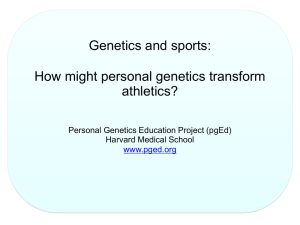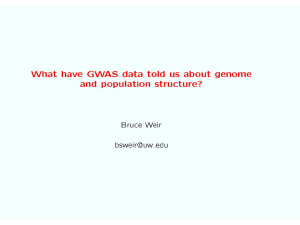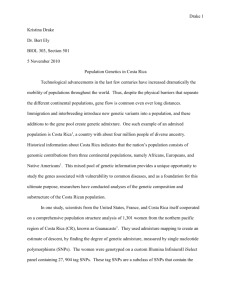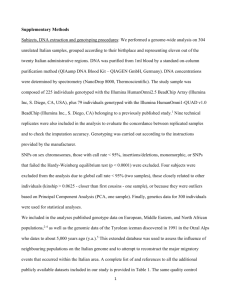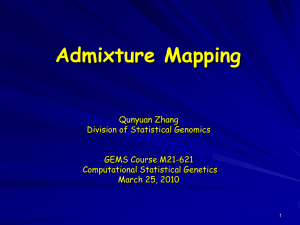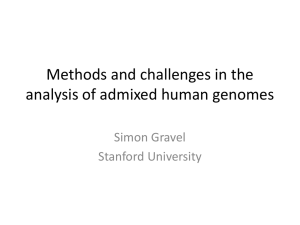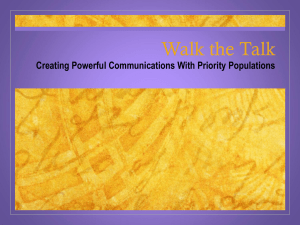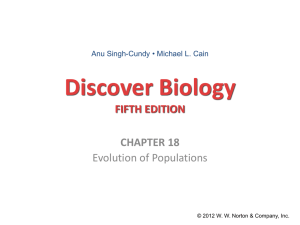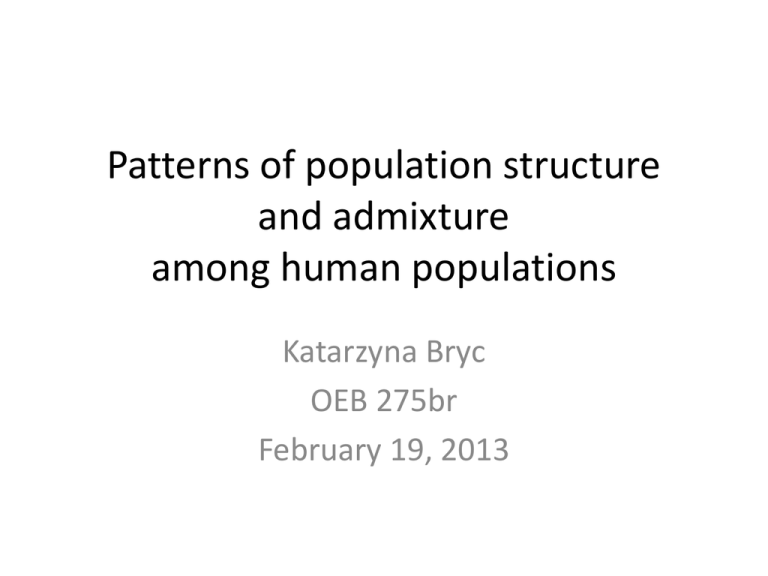
Patterns of population structure
and admixture
among human populations
Katarzyna Bryc
OEB 275br
February 19, 2013
Outline
• The field of population genetics
• Learning about human history from genetics
– Out of Africa settlement of continents
– Admixture: gene flow between diverged
populations
– African American admixture
– An update to Out of Africa
Early work
Er, Apatosaurus?
Reanalysis of data, or subsequent research,
can lead to different conclusions
O.C. Marsh, 1896
Shift in the understanding of human
history
• New data from old bones leads to new
conclusions
– Museum collections will be key
– Challenges:
• DNA preservation and no modern contamination
• Online databases
– Huge resources
– Challenges:
• Human subjects research requires careful consent and
ethics review
Outline
• The field of population genetics
• Learning about human history from genetics
– Out of Africa settlement of continents
– Admixture: gene flow between diverged
populations
– African American admixture
– An update to Out of Africa
Population genetics
• Sewall Wright, B.S. Haldane, R.A. Fisher
– early 1900’s
• Study allele frequency distribution and change
• Evolutionary processes of
– natural selection
– genetic drift
– mutation
– gene flow
– population structure
DNA
DNA
Reference
sequence
…TCAGGTCACAGTCT…
…TCAGGTCACAGTCT…
Individual 2 …TCAGGCCACAGTCT…
Individual 3 …TCAGGCCACAGTCT…
Individual 1
Single Nucleotide Polymorphism (SNP)
…TCAGGTCACAGTCT…
…TCAGGCCACAGTCT…
…TCAGGCCACAGTCT…
SNP
A.k.a. allele, locus, marker, variant
Mutation
time
Allele frequency: 1/N
Infinite sites model
Genetic drift
time
Allele frequency = 10%
Allele frequency = 30%
Drift is faster in smaller populations
Natural selection
Allele frequency = 30%
Allele frequency =50%
Selection strength s
What genes are under selection?
Population structure
Population 1
67%
Barrier
Population 2
17%
30%
Randomly mating
Population substructure
Random mating within populations
Can have gene flow between pops
Pigmentation example - SLC45A2
ALFRED: The ALlele FREquency Database
http://alfred.med.yale.edu/alfred/
Outline
• The field of population genetics
• Learning about human history from genetics
– Out of Africa settlement of continents
– Admixture: gene flow between diverged
populations
– African American admixture
– An update to Out of Africa
What can genetics tell us about
population structure?
Principal Components
Analysis (PCA)
Isolation-By-Distance
Novembre et al. 2008, Nature
Tools of the trade
Samples
• Modern populations
• Ancient DNA
Statistical Methods
Technology
•
•
• Genotyping arrays
• Sequence data
PCA (Patterson 2006)
STRUCTURE (Falush 2003)
Outline
• The field of population genetics
• Learning about human history from genetics
– Out of Africa settlement of continents
– Admixture: gene flow between diverged
populations
– African American admixture
– An update to Out of Africa
Out of Africa
Henn et al. 2012, PNAS
Worldwide substructure
Worldwide Human Relationships Inferred from
Genome-Wide Patterns of Variation
Li et al. 2008, Science
Admixture with Hominids?
Gene flow from
archaic populations
(ie, Neandertals) into
modern humans?
Scientific American
Outline
• The field of population genetics
• Learning about human history from genetics
– Out of Africa settlement of continents
– Admixture: gene flow between diverged
populations
– African American admixture
– An update to Out of Africa
What is admixture?
1
2
Ancestral
populations
Gene flow between populations
G1
G2
In subsequent generations
segments become shorter
What we know from history about the
Trans-Atlantic Slave Trade
From: Atlas of the Transatlantic Slave Trade, Eltis and Richardson, based on www.slavevoyages.org
African American admixture
• Can we learn more using genetic data?
Africans
Europeans
South Asians
East Asians
African Americans
What we know from genetics
• African ancestry primarily from West Africa
[Lovejoy 2000, Salas 2005, Price 2009, Tishkoff 2009]
• Variation in African vs. European ancestry proportion
[Parra 1998, Parra 2001, Smith 2004, Lind 2007, Bryc 2010]
• Evidence for sex-bias in ancestry contributions
[Parra 2001, Lind 2007, Bryc 2010]
Local ancestry
“Chromosome painting”
• African vs European proportions vary
• Sex bias in ancestry contributions
• mtDNA and Y chromosome haplotypes
Bryc et al. 2010, PNAS
Outline
• The field of population genetics
• Learning about human history from genetics
– Out of Africa settlement of continents
– Admixture: gene flow between diverged
populations
– African American admixture
– An update to Out of Africa
Hunt for Neandertal admixture
• mtDNA does not
recombine
– Neandertal outgroup to
all modern humans
– No signal of admixture
– Last common ancestor ~
500,000 years ago
~500kya
mtDNA tree
Neandertal autosomal genome
• Bone powder -> much
work -> DNA sequence
• Analysis reveals low
levels of gene flow into
all non-Africans
• Explore the Neandertal
genome on Ensembl or
UCSC Genome Browser
A Draft Sequence of the Neandertal Genome
Green et al. 2010, Science
Another hominid: Denisova
• Tooth and finger bone from
Altai mountains in Siberia
• Distinct from Neandertal
• Analysis reveals gene flow
into modern humans, but
only into Oceania
– Australia and Papua New
Guinea
Neandertal
Modern
humans
Genetic history of an archaic hominin group
from Denisova Cave in Siberia
Reich et al. 2010, Nature
Admixture appears to be quite
common in human history
• Sequencing of two archaic genomes reveal
both had gene flow into modern humans
• Further, evidence of archaic gene flow into
Africans (of unknown origin)
• Lots of other expansion and admixture events
(European Farmers, Bantu expansion in Africa)
Database resources
• ALFRED (ALlele FREquency Database)
• dbGaP (database of Genotypes and Phenotypes)
– NCBI: National Center for Biotechnology Information,
through NIH
• UCSF Genome Browser, Ensembl
• Publicly available data generated thanks to:
–
–
–
–
Neandertal Project
Haplotype Map Project (HapMap)
1000 Genomes Project
Human Genome Diversity Project (HGDP)
• Human data has some unique challenges
Thanks!

